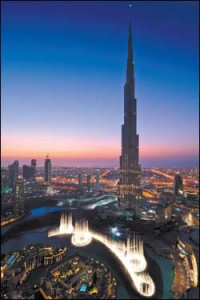By Laura Battle www.ft.com
“Brand before product” was the great marketing milestone of the 1990s but few companies have taken it quite as literally as Sunland Group.

The Australia-based developer has put a huge amount of energy and resources – and a total of AED2.3bn (£400m) – into Palazzo Versace Dubai, a joint venture with Emirates International Holdings that combines hotel accommodation with residential property on the banks of Dubai Creek, although the project is yet to be fully realised.
As with many developments in Dubai, work on Palazzo Versace slowed, and sales slumped, as a result of the economic crash of 2008. Soheil Abedian, managing director of Sunland Group, insists it will see the project through but it will not be completed for another 12 to 14 months. As well as designer cachet – every last detail of the interior has been supplied or approved by the Versace fashion house – much has been made of the development’s location within the planned Culture Village.
This complex of exhibition halls, an amphitheatre and outdoor sculptures, the brainchild of Sheikh Mohammed bin Rashid al-Maktoum, prime minister of the UAE, has been heralded as a stimulus for Dubai’s growing arts scene.
The completion of the Culture Village has since slowed but Abedian is confident the vital infrastructure will be in place for Palazzo Versace. Only about 30 per cent of the properties remain to be sold but Dubai’s property market remains unstable and potential buyers are now being tempted by massive reductions: the project launched with two-bedroom apartments priced at AED8.5m (£1.4m); during the boom period this rose to AED17.5m (£2.9m) and as a result of the current property market the price has returned to AED8.5m.
Palazzo Versace was, as the name suggests, inspired by the format of traditional European palaces: a central public area, comprising restaurants, bars, shops and hotel accommodation will be flanked by 169 residential apartments. A tour of the completed showroom apartment confirms an attempt at timeless Italian grandeur – a sort of quick-fix Villa Farnesina: the floors are polychrome marble, the fabrics a riot of Italian grotesques, while the cutlery comes in an alarming shade of gold.
The Versace logo, the Medusa head, is stamped like a dynastic crest over cushion covers and cut-glass tumblers. “It is Renaissance in style with something of the Islamic tradition and a dash of modernity,” Abedian says.
Designer property is not a new idea but it is one that Abedian claims to have coined. In 1998, he approached Versace with plans for a branded hotel-residential development on Australia’s Gold Coast, “because Versace was the first fashion label to go beyond dressing the person to dressing the environment”. Since the completion of the first Palazzo Versace in 2000, the trend for designer hotels and residential units has gained rapid momentum.
Last year the Armani Hotel Dubai opened in the Burj Khalifa, a multipurpose skyscraper in the Downtown Dubai district and the world’s tallest building. As well as shops, bars, a spa and eight different restaurants, the Armani Hotel, a joint venture with Emaar Properties, includes 144 one- and two-bedroom residential units ranging between 1,076 sq ft and 2,153 sq ft. Apartments are minimalist and neutral – an aesthetic that is somewhat at odds with the glinting colossus that serves as their host – and furnished with the designer’s home range.
Elsewhere, wood-panelled corridors give the impression of being inside an ark (you could run with the metaphor) and promo blurb claims to offer “smooth, understated style” within the symbolic heart of this brash and throbbing metropolis. It’s an amusing contradiction.
Armani will not disclose prices but, according to Catherine Clarke, head of residential valuations at the real estate service company Colliers International, anecdotal prices for these properties on the secondary market range from AED4,000-5,000 (£668-£835) per sq ft.
A Colliers International report indicates that average prices for apartments in the Burj Khalifa have dropped from $1,437 per sq ft in 2008 to $958 in 2010 but Clarke suggests that while the Armani residences have declined over that two-year period, they enjoyed a stronger position at the start because of brand association.
Designer properties seem appropriate for Dubai, where retail is the main tourist attraction and the skyline blazes with neon logos, but they will soon be appearing in a number of other locations.
Next spring Bulgari will open a new hotel in London that will include one penthouse and six other residences, and Armani has plans to open two further hotel-residential complexes in Marrakech and Marassi by 2013. These developments do not simply bear the mark of a noted architect or celebrity interior designer, they are comprehensive outfits and they appeal to a new generation of wealthy buyers, happy to surrender their environment to the tastes of a single fashion house. This is branding taken to an ultimate conclusion: life according to one label.
Many will be disturbed by the sudden success of designer property over the past decade and the implications of cultural brainwashing – not to mention the increasing economic dominance of the big brands. Fashion is fickle and the excitement surrounding designer property could quickly fizzle out but the trend has shown a remarkable resilience so far.
Laura Battle is deputy editor of House & Home. She was a guest of Sunland Group and Emirates Airlines














